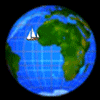Richard Konkolski - Knihy Konkolski s.r.o.
|
| DOMŮ |
|
|
FILMY-DVD | TELEVIZE | ROZHLAS | ČLÁNKY | SEDM MOŘÍ | SÓLO SAILING |
|
|
|
|
||
The Great Age of Discovery - 15th CenturyIt may be imagined to what a fiery heat Europe turned in, when the wonderful accounts of the gold and charming beauty of Haiti spread from country to country. Half of Europe had thrown itself upon the Orient to liberate the tomb of our Savior from the tyranny of the Moslem, so one flood of adventurers followed another to the new land of promise with colorful prospects of wealth and enjoyment. With great jealousy, England and France entered the path on which Portugal and Spain had so gloriously preceded them. As the result of this competition the whole western shore of the Atlantic basin was drawn into the circle of the known earth. John and Sebastian Cabot Beginnings of English Navigation Their voyage is also remarkable as having been the first expedition that ever left the shores of England. On this occasion it may be interesting to mention about the beginnings of British navigation. In the year 1217 the first treaty of commerce was concluded with Norway. In the beginning of he fourteenth century Bergen was the most distant port to which English vessels resorted. Soon afterwards they ventured into the Baltic. It was not before the middle of the following century that they began to sail to the Castilian and Portuguese ports. Towards the end of the fifteenth century the English flag was still a stranger to the Mediterranean. The direct communication with the Levant only began in the sixteenth century. Edward the Second, preparing for his great Scottish war, was thankful to hire five galleys from Genoa. Ojeda and Amerigo Vespucci About the same time a Portuguese fleet, sailing under the command of Pedro Alvarez Cabral to the Indian Ocean, was driven by adverse winds to the coast of the Brazils, so that, if the genius of Columbus had not evoked, America would have chance to be discovered a few years later. A third voyage, which renders the year 1500 is that of Gaspar Cortereal, a son of John Vaz Cortereal is one of the doubtful forerunners of Columbus. Hoping to realize the dream of a north-west passage to the riches of India, Gaspar sailed along the inhospitable shores of Labrador, and penetrated into the Gulf of St. Lawrence. Storms and ice-drifts forced him to retreat but he again set sail in the following year with two small vessels. On this second voyage he supposedly penetrated into Frobisher Bay, but here floating ice-masses and violent gales separated him from his companion ship, which returned alone to Portugal. The doubtful destiny of the Portuguese explorer gave his brother Miguel no rest. The following spring found him sailing with three ships on the traces of the lost Gaspar. But Miguel also disappeared for ever among the ice-fields of the north. A third brother remained, who earnestly implored the king that he also might be allowed to go and sail this treacherous waters. But Emanuel refused permission, saying that these enterprises had already cost him two of his most valuable servants, and he could not afford to lose more. Vincent Yanez Pinson In 1512 Juan Ponce de Leon sailed to Florida, where, instead of finding as he hoped the fountain of eternal youth, he is doomed to a miserable end. In 1517 the above mentioned Solis sails along the coasts of the Brazils to the mouth of the Rio de la Plata, where he is killed in a conflict with the Indians. In 1518 Cordova makes his countrymen acquainted with the north and west coasts of Yucatan, and in the same year Grijalva discovers the Mexican coast from Tabasco to San Juan de Ulloa. Cortez Verazzani and Cartier Thus within half a century after the day when Columbus first landed on Guanahani, we find almost the whole eastern coast of America rising from an unknown past. The Portuguese in the Indian Ocean Now the great revolution in commerce took place which the Venetians long had feared and the Portuguese had hoped for. Portuguese lost no time in reaping the golden fruits of the glorious discoveries of Vasco de Gama and his predecessors. In less than twenty years their flag waved in all the harbors of the Indian Ocean, from the east coast of Africa to Canton Shortly a row of fortified stations secured to them the dominion of the seas. Their settlements in Diu and Goa awed the whole coast of Malabar, and cut off the intercourse of Egypt with India by way of the Red Sea. They took possession of the small island of Ormus, which commands the entrance of the Persian Gulf and rendered this important commercial highway likewise tributary to their power. In the center of the East-Indian world rose their chief market-place, Malacca, and even in distant China Macao obeyed their laws. The discovery of the Molucca Islands gave them the monopoly of the lucrative spice trade, which was destined at a later period to enrich the economical Dutchman. What vast changes had taken place since Prince Henry's first expeditions to the coast of Africa. During one life time the old Atlantic Ocean enlarged his boundary into the boundless world of waters from the coasts of Canton to the West Indies. Few years later the Pacific opens its gates, and all the discoveries of Columbus and Vasco seem small when compared with the vast regions which Magellan reveals to man. Back to Maritime Discovery |
||||||||||||||||||||||||
|
||||||||||||||||||||||||


